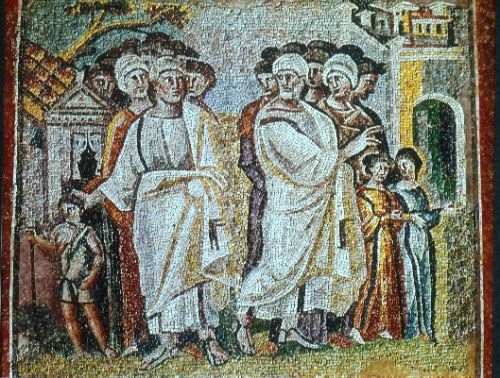The Parting Of Lot And Abraham on:
[Wikipedia]
[Google]
[Amazon]
 ''The Parting of Lot and Abraham'' is one in a series of
''The Parting of Lot and Abraham'' is one in a series of
 ''The Parting of Lot and Abraham'' is one in a series of
''The Parting of Lot and Abraham'' is one in a series of mosaic
A mosaic () is a pattern or image made of small regular or irregular pieces of colored stone, glass or ceramic, held in place by plaster/Mortar (masonry), mortar, and covering a surface. Mosaics are often used as floor and wall decoration, and ...
scenes, probably dating to the 430s, decorating the nave wall of Santa Maria Maggiore
Santa Maria Maggiore (), also known as the Basilica of Saint Mary Major or the Basilica of Saint Mary the Great, is one of the four Basilicas in the Catholic Church#Major and papal basilicas, major papal basilicas and one of the Seven Pilgrim C ...
, one of the most prominent basilica
In Ancient Roman architecture, a basilica (Greek Basiliké) was a large public building with multiple functions that was typically built alongside the town's forum. The basilica was in the Latin West equivalent to a stoa in the Greek Eas ...
n churches in Rome
Rome (Italian language, Italian and , ) is the capital city and most populated (municipality) of Italy. It is also the administrative centre of the Lazio Regions of Italy, region and of the Metropolitan City of Rome. A special named with 2, ...
. The mosaic shows the story in the Book of Genesis
The Book of Genesis (from Greek language, Greek ; ; ) is the first book of the Hebrew Bible and the Christian Old Testament. Its Hebrew name is the same as its incipit, first word, (In the beginning (phrase), 'In the beginning'). Genesis purpor ...
of the parting of Abraham
Abraham (originally Abram) is the common Hebrews, Hebrew Patriarchs (Bible), patriarch of the Abrahamic religions, including Judaism, Christianity, and Islam. In Judaism, he is the founding father who began the Covenant (biblical), covenanta ...
from his nephew, Lot
Lot, LOT, The Lot or similar may refer to:
Common meanings Areas
*Land lot, an area of land
*Parking lot, for automobiles
*Backlot, in movie production
Sets of items
*A great many of something, as in, "There are a lot of beetles," or "There are ...
, as they choose opposing paths. Abraham (on the left), with Isaac
Isaac ( ; ; ; ; ; ) is one of the three patriarchs (Bible), patriarchs of the Israelites and an important figure in the Abrahamic religions, including Judaism, Christianity, Islam, and the Baháʼí Faith. Isaac first appears in the Torah, in wh ...
and the rest of his family, chooses the road to Canaan
CanaanThe current scholarly edition of the Septuagint, Greek Old Testament spells the word without any accents, cf. Septuaginta : id est Vetus Testamentum graece iuxta LXX interprets. 2. ed. / recogn. et emendavit Robert Hanhart. Stuttgart : D ...
, as God intends him to, and Lot chooses to take his followers to Sodom.
The work is a tessera
A tessera (plural: tesserae, diminutive ''tessella'') is an individual tile, usually formed in the shape of a square, used in creating a mosaic. It is also known as an abaciscus or abaculus.
Historical tesserae
In early antiquity, mo ...
mosaic, tessera describing the material making up the surface of the work. Most tessera works during this time would be made up of small pieces of limestone or marble, cut to shape, and arranged by the artist.
The artist uses several conventions of the time. The grouping of the characters is varied, meant to create the illusion of space. This "shorthand" way of depicting a crowd is sometimes called a "head cluster". There is a hieratic abandonment of consistent and realistic proportions and scale, allowing the artist to put emphasis on the characters of his choosing using attributes like size. The main characters we are intended to focus on are made extremely clear through this method, and the picture itself becomes less illustrative and more symbolic. Eventually, this style comes to refined maturity during the Middle Ages. The move towards completely two-dimensional representative images has already started, and although this mosaic implements the use of lights and darks, with shadows corresponding to the figures, there is a good indication as to what direction religious art is heading.Kleiner, Fred S. Gardner's Art Through the Ages: A Global History. 13th ed. Belmont: Wadsworth, 2008.
Notes